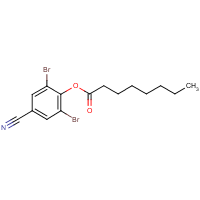Bromoxynil octanoate
Agent Name
Bromoxynil octanoate
CAS Number
1689-99-2
Formula
C15-H17-Br2-N-O2
Major Category
Pesticides

Synonyms
2,6-Dibromo-4-cyanophenyl octanoate; 3,5-Dibromo-4-hydroxybenzonitrile octanoate; 3,5-Dibromo-4-octanoyloxy-benzonitrile; 4-Cyano-2,6-dibromophenyl octanoate; Brominal W; Bromoxynil octanoic acid ester; M&B 10731; NPH 1320; Octanoic acid ester of 3,5-dibromo-4-hydroxybenzonitrile; RP-16272; Benzonitrile, 3,5-dibromo-4-octanoyloxy-; Octanoic acid, 2,6-dibromo-4-cyanophenyl ester; [ChemIDplus]
Category
Herbicides, Other
Description
Solid; [Merck Index] Nearly white crystalline solid; [MSDSonline]
Sources/Uses
Used as herbicide for cereals, field corn, popcorn, other crops, and alfalfa in Conservation Reserve Program; [HSDB]
Comments
A mild skin and eye irritant; May cause skin sensitization; Effects in a 13 week feeding study with rats include decrease in body weight (not associated with decrease in food intake), increased kidney and liver weights, hematological changes, and myocardial degeneration and necrosis; "Four workers in a manufacturing plant making both bromoxynil and ioxynil developed typical symptoms of uncoupler poisoning including excessive perspiration, thirst, fever, emesis, myalgia, and weight loss. ... The effects reversed rapidly after exposure ceased." [HSDB] May cause skin sensitization; [eChemPortal: ESIS] May cause irritation; May cause skin sensitization; [MSDSonline] See "Bromoxynil."
Biomedical References
Exposure Assessment
PEL (OSHA)
5 mg/m3, as CN
MAK
2 mg/m3, inhalable fraction, as CN
Vapor Pressure
4.8E-06 mm Hg
Lethal Concentration
LC50 (rat) = 720 mg/m3;
Reference Link #2
Adverse Effects
Skin Sensitizer
Yes
Hepatotoxin
Hepatoxic (a) from occupational exposure (secondary effect) or (b) in animal studies or in humans after ingestion
Other Poison
Uncoupler
Diseases, Processes, and Activities Linked to This Agent
Diseases
Occupational diseases associated with exposure to this agent:
Processes
Industrial Processes with risk of exposure: